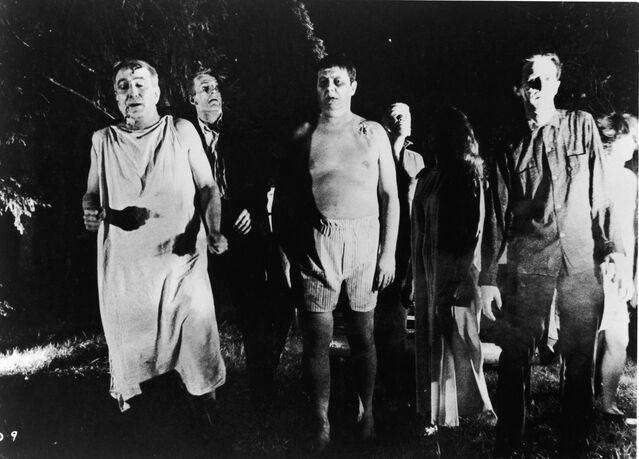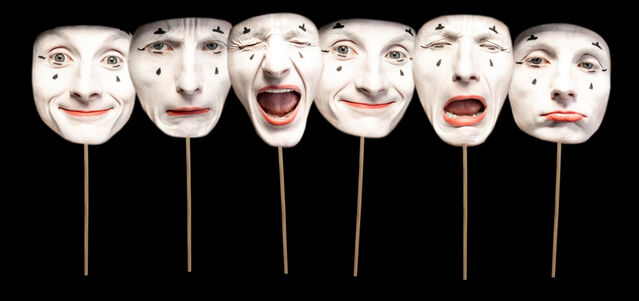Memes
Are We All Zombies? (Are Humans Truly Conscious?)
Part 4: Consciousness is a user-illusion, but infused with emotion and culture.
Posted October 15, 2020 Reviewed by Lybi Ma

This is Part 4 of a five-part series on the evolutionary origins of consciousness. I encourage you to read Part 1 first, for the overall context. Parts 2 to 5 look in a little more detail (but still necessarily in a summarized manner) at each of six books by scientists focusing on this intriguing, fundamental way of understanding consciousness. Here in Part 4, we will discuss the theories of, first, Daniel Dennett and then Antonio Damasio.
Competence without comprehension
In his book From Bacteria to Bach and Back: The Evolution of Minds,1 philosopher and cognitive scientist Daniel Dennett argues that consciousness and the sense of self are essentially illusions. His main point in this book is that evolution has produced competent behavior without comprehension, by which he means that most animals behave in highly effective ways without consciousness. Indeed, even we humans perform a great many actions without conscious awareness or understanding of what we are doing and why. A lot of our actions are automatic. This is true not only for well-practiced routine tasks, like walking, talking, or driving a car but also for all kinds of even more complex, less habitual behaviors. Our motivations for doing things are often unknown to us. Or we think we know them, attributing them to certain reasons, when in fact we may have quite different unconscious motives—something I frequently discover as a psychiatrist trying to help my patients understand their own motivations.
Consciousness as a user-illusion
Consciousness is not what it seems. Dennett calls it an “evolved user-illusion,” a user-interface that smooths over the intricate underlying details. Nature uses the “need to know” principle. Most mental operations can operate just fine without comprehension, without consciousness, though we feel as if we are fully conscious agents.
For the brain to have evolved an awareness of all its underlying operations would have been inefficient. That would have required an overwhelming amount of additional information processing and would have conferred no additional adaptive advantage. Consequently, we only have access to a very edited version of the net results of our underlying brain processes. When we attempt to explain the exact reasons and motivations for all our actions, we are basically confabulating what we think has happened. The more specific underlying neuronal machinations are hopelessly beyond our self-knowledge.2
Qualia and subjective experience
Philosophers of Mind tend to emphasize what they call the "hard problem" of consciousness—how to explain what they call qualia: the very subjective quality of conscious experience, the feeling of, say, the redness of seeing red. But Dennett dismisses the supposed mystery of qualia, arguing that what we think of as a direct inner experience is just an illusion. He argues that the first-person point of view—subjectivity—is nothing special and is not more reliable than any other point of view, such as that of a brain scientist studying our brain, into what is really taking place in our brain’s underlying processes.3
Memes: language and culture
What made the enormous difference between humans and other animals, according to Dennett, is the ability to share memes, especially language. Memes are units of cultural transmission that spread through processes similar to natural selection, in ways analogous to genes, or analogous to viruses infecting minds.4 Words, the units of language, are memes. They are among the most useful, flexible, and powerful of all memes.
Memes spread especially profusely in humans in part because we are such a prodigiously imitative species and because we have the cognitive capacity, especially linguistic ability, to imitate very complex memes. Cultural evolution (the process of natural selection of memes), especially via language, quickly outstripped biological evolution in a runaway amplifying process leading to increasing intelligence, comprehension, and creativity. Cultural evolution is cumulative, which adds immensely to its power.
Memes as apps
In Dennett's theory, memes are to our brains as software is to a computer or as apps are to a smartphone, enabling the already highly developed hardware to perform a much wider range of functions and making the outputs more accessible and comprehensible to the user. He argues that just a few thousand years of cultural evolution designed thinking tools—“virtual machines” that could travel and spread and be installed on different brains, imposing novel structures on those brains, giving those brains powers they otherwise wouldn't have. Or as he likes to put it, “apps that we download into our neck-tops.” Without the 'software' of memes, our neuronal hardware would merely have competence without comprehension.
Our billions of neurons are as mindless and robotic as a termite colony—able to function cooperatively and achieve amazing feats in terms of functioning, but not able to explain what they’re collectively doing, to themselves or to other brains, and lacking functional versatility. Language and culture, according to Dennett, are what make those extra feats possible. Language confers practically unlimited versatility to our ability to form cognitive representations of our thoughts and to communicate and transmit culture.5
A strange inversion of reasoning
In explaining how all this complexity could have resulted from a mindless bottom-up evolutionary process, Dennett attributes to Darwin and Turing a strange but true “inversion of reasoning,” namely: “all the brilliance and comprehension in the world arises ultimately out of uncomprehending competences compounded over time into ever more competent—and hence comprehending—systems” (p.57). True intelligent designers—us—have been produced by processes having the appearance of, yet utterly lacking in, intelligent design. Natural selection is the blind ‘Intelligent Designer.’ Consciousness and comprehension (i.e. mind) is the effect, not the cause.

Homeostasis
Let's turn now to neuroscientist Antonio Damasio and his book The Strange Order of Things: Life, Feeling, and the Making of Cultures.6 Damasio emphasizes perhaps even more than most other neuroscientists the fundamental role of bodily (“somatic”) perceptions in the evolution and development of the brain. He also emphasizes the central role of emotions. Damasio theorizes that the most basic building blocks of consciousness are the neural representations or mapping of the body in the brain, and the brain’s homeostatic (equilibrium) and regulating mechanisms for the body.7
Organisms that could ‘experience’ and ‘feel’
A simple unicellular organism could merely “sense” or “register” things in its internal and external environment and make homeostatic adjustments to sustain itself. Unicellular organisms evolved into multicellular organisms, which then evolved nervous systems, some 600 million years ago. A nervous system provides an internal map (internal representations) for the organism of its own bodily structures and of the external world (as described by Feinberg and Mallatt, and by LeDoux, reviewed in Parts 2 and 3).
Nervous systems soon evolved the additional capacity to enable a primitive form of evaluation, the attachment of ‘valence’ or value—external objects being marked as ‘good’ or ‘bad’ for the organism’s survival.8 This is the precursor to emotion and is what Feinberg and Mallatt refer to as affective consciousness. Damasio formulates this as a very early form of subjective experience, an early form of ‘feeling.’ Notice the contrast to LeDoux’s theory, discussed in Part 3—LeDoux argues that true feeling states evolved late, as higher cognitive processes, whereas Damasio argues that they evolved early (though Damasio would agree that these early feeling states were very primitive).9
Critically important for Damasio is that feelings must be understood as inextricably embodied. The mind is not separate from the body.
On the ‘hard problem’ of explaining why consciousness feels like something (at least in humans, and presumably in other animals), Damasio states:
"Mental states naturally feel like something because it is advantageous for organisms to have mental states qualified by feelings. Only then can mental states assist the organism in producing the most homeostatically compatible behaviors. In fact, complex organisms such as ours would not survive in the absence of feelings. Natural selection made certain that feelings would become a permanent feature of mental states." (p. 161)
The role of emotion in human motivation, and the making of cultures
Damasio emphasizes the centrality of feelings and their underlying emotions to human motivation. They inform us when something is disturbing our homeostasis and they drive us to take action to correct it. Feelings also provide us with feedback on our social relations. They are thereby crucial to our survival and flourishing. And they are a driver of culture.
Like Dennett, Damasio emphasizes the pivotal role of culture in human evolution. He argues that feeling is the prime motivator that has fueled and shaped the development of culture, the factor that makes it all matter to humans:
“Language, sociality, knowledge, and reason are the primary inventors and executors of these complicated processes. But feelings get to motivate them and stay on to check the results, and help negotiate the necessary adjustments. The idea, in essence, is that cultural activity began and remains deeply embedded in feeling.” (p.5)
He draws a link to social behaviors in simpler animals. Even in very simple organisms, elements of these behaviors could be seen, foreshadowing human cultural behavior:
“In early organisms, homeostasis generated the precursors to feeling and subjective perspective in the absence of mental processes. Neither feelings nor subjectivity was present, only the mechanisms that were necessary and sufficient to help regulate life prior to the development of nervous systems and minds.” (p.167)
Both Dennett and Damasio emphasize that complex mental phenomena have evolved from much simpler chemical processes through a gradual bottom-up process: “Feelings arose from a series of gradual, body-related processes, bottom up, from simpler chemical and action phenomena accumulated and maintained over evolution.” (Damasio, p. 161). Evolution is a completely natural, purely physical process that is entirely spontaneous and unguided. There is no magical or nonphysical ingredient added or needed.
So, are we all zombies? It probably depends on your definition of zombies. But we are not as fully and freely conscious as we think. Consciousness is a user-illusion, blindly honed by biological evolution, but layered with language and culture and deepened by the chemistry of emotion.
Part 5 of this five-part series looks at the further insights provided by neuroscientist Michael Graziano into the evolution of consciousness.
References
1. Daniel C. Dennett, From Bacteria to Bach and Back: The Evolution of Minds (New York: W.W. Norton & Company, 2017).
2. We shall see in Part 5 that Michael Graziano makes similar arguments to Dennett regarding the illusion of consciousness and the brain’s ignorance of its own underlying processes.
Both Dennett and Graziano favor and further develop the Global Workspace Theory (GWT) of consciousness. GWT is a theory originally developed by Bernard Baars and further developed by Stanislas Dehaene and colleagues into a global neuronal workspace theory. According to the theory, only one piece of information at a time can gain access to a "global neuronal workspace:" Neuronal signals compete with each other constantly. When one set of signals (for example, visual processing of a particular object such as an apple) becomes enhanced and boosted, out-competing other signals, then it becomes strong enough to influence widespread networks around the brain (this is referred to as “ignition”). In that moment, that particular set of signals (containing features of the apple) dominates the brain’s processing such that it becomes the focus of the brain’s conscious attention. Dennett refers to this as the signal gaining “fame in the brain.”
3. Dennett dismisses the notion of qualia as useless, poorly defined, and having no functional evolutionary value according to its own definition. Reading Dennett, one sometimes comes away with the impression that consciousness itself does not necessarily have a whole lot of adaptive advantage in terms of biological evolution and that it's something of an evolutionary afterthought or incidental byproduct, though that is not exactly what he is saying. Nevertheless, he doesn’t attach much value to the very subjective experience of consciousness as a reliable window into what's really going on in the brain.
We saw in Parts 2 and 3 that Feinberg and Mallatt, and LeDoux, had somewhat different takes on the value of subjective experience. They argue that consciousness is adaptive. They note that the most efficient way to direct your behavior is to build a realistic mental image of the world that you can refer to in guiding your behavior. They further argue that affective consciousness (the ‘likes’ and ‘dislikes’ of an animal) is crucial in determining approach / avoidance behavior. And ‘qualia’ are additionally adaptive in the finer discrimination of sensory experience—the ability to more finely differentiate one thing from another (e.g. color / hue), to aid survival. They would agree with Dennett that we can and do carry out many if not most of our actions using nonconscious thought processes, but they more strongly emphasize the added adaptive value of conscious thought processing (Feinberg and Mallatt, in particular, quite explicitly do not take the position that consciousness is an illusion; they regard it as an emergent phenomenon).
Another neuroscientist, Stanislas Dehaene, sums up the trade-off between nonconscious and conscious cognitive processes: nonconscious processes work well for practiced, routine, reflexive speech and action, but consciousness is required for higher level thinking and action characterized by careful deliberation and planning—the kind of thought processes that involve holding information in working memory and systematically manipulating that information [Stanislas Dehaene, Consciousness and the Brain: Deciphering How the Brain Codes Our Thoughts (New York, NY: Viking, 2014).]
[CLICK 'MORE' TO VIEW FOOTNOTES 4-9]
4. The term "meme" has been appropriated from the original scientific meaning to refer more particularly to a video, picture, text, etc. spread via the internet. Indeed, the term "meme" has itself spread memetically.
5. According to Dennett, many “apps” depend on other “apps” that depend on other “apps”. In the end we have a multicompetent entity (our culturally adapted brain) that can do things that the “bare brain” (our basic mammalian brain) can’t do by itself. Dennett regards human consciousness as a huge complex of memes. “Our thinking is enabled by the installation of a virtual machine made of virtual machines made of virtual machines.” (From Bacteria to Bach and Back, p.341) (i.e. complex systems constructed out of less complex subsystems). Driving it all is the human need for, and capacity for, communication, as the most social of all species. We need to communicate our intentions and our self-perceived motivations to others when we cooperate with them, and we need to cleverly conceal these or deceive others when we compete with them. This need to communicate reasons for our behaviors leads to greater comprehension of our own behaviors. Thus it is through language and culture that humans achieve competence with comprehension. But still, we never come close to a complete understanding of our own underlying cognitive processes and the full complicated reasons for why we do the things we do. We can never really see what's "under the hood" of our internal machinations. Consciousness is still an illusion according to Dennett.
6. Antonio R. Damasio, The Strange Order of Things: Life, Feeling, and the Making of Cultures (New York: Pantheon Books, 2018).
7. In one of his previous books, Looking for Spinoza: Joy, Sorrow, And the Feeling Brain, Damasio explains the centrality of homeostasis:
"All living organisms from the humble amoeba to the human are born with devices designed to solve automatically, no proper reasoning required, the basic problems of life. Those problems are: finding sources of energy; incorporating and transforming energy; maintaining a chemical balance of the interior compatible with the life process; maintaining the organism’s structure by repairing its wear and tear; and fending off external agents of disease and physical injury. The single word homeostasis is convenient shorthand for the ensemble of regulations and the resulting state of regulated life." [Antonio R. Damasio, Looking for Spinoza: Joy, Sorrow, And the Feeling Brain (Orlando, FL.: Harcourt, 2003), pp. 30-1.]
8. Actually, a very primitive form of valence evolved much earlier, in unicellular organisms: bacteria will move toward food (e.g. glucose), thus sensing it as ‘good’ for survival, and will move away from toxins—‘bad’ for survival.
9. In Damasio’s model, consciousness is brought about by feelings intersecting with a sense of self, with the self recognizing that it is having the feelings. There are higher levels of such awareness in more complex animals, all the way to humans with our autobiographical sense of self.




